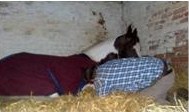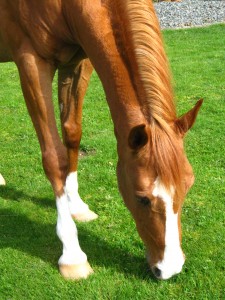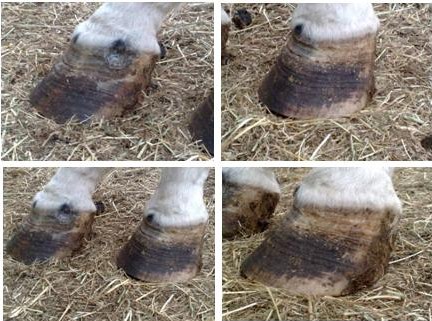Posts Tagged ‘laminitis’
The Do’s & Don’ts of Laminitis (Part 2)
The previous article, “The Do’s & Don’ts of Laminitis (Part 1),” by Marijke van de Water, Equine Health & Nutrition Specialist, Homeopathic Practitioner, and Medical Intuitive & Healer, explored a few “don’ts” for ensuring the optimal health of a laminitic horse. See below for part 2 of this article, which outlines a few more “do’s and don’ts” when caring for a laminitic horse.
~~~~~~~~~~~~~~~~~~~~~~~~~~~~~~~~~~~~~~~~~~~~~~~~~~~~~~~~~~~~~~~~~~~
The Don’ts
Don’t confine a laminitic horse no matter how sore they are – horses need movement and exercise to improve circulation and deliver nutrients to toxic and damaged hoof tissues. Let the sore horse decide how much movement he/she needs. Metabolic horses with laminitis need exercise to regulate blood sugar levels and to reverse their condition.
Don’t use glucosamine long-term, if at all – glucosamine is a type of sugar that strains the liver and depresses insulin production in sugar sensitive, overweight and/or metabolic horses.
Don’t accept hoof pathologies as normal (no matter what breed): flaring walls, bell-shaped hooves, cracking, splitting, soft soles, flat soles, long toes, high heels, contracted heels and/or under-run heels are all abnormal and can be fixed with a professional barefoot trim, exercise and a good diet.
Don’t always accept the label of “navicular” – this is an over-used diagnosis to explain unexplained symptoms. Many cases of so-called navicular are actually sub-clinical laminitis.
Don’t listen to well-meaning people who tell you that your horse won’t recover – they are misinformed.
The Do’s
Do feed horses a high fibre diet (e.g. hay, beet pulp, soybean hulls, flax seeds, chia seeds, hemp seeds, wheat bran, wheat germ) – fibre detoxifies the liver and hindgut, regulates appetite, lowers the glycemic index of all feeds and encourages weight loss.
Do use slow feeders to lower stress levels, ease digestion and provide forage 24/7.
Stay Tuned for Part 3
In Part 3, we will share Marijke’s words on a few more “do’s” to ensure the optimal health of a laminitic horse.
More from Marijke van de Water:
Website: http://www.rivasremedies.com
Twitter: @rivasremedies
Facebook: facebook.com/rivasremedies1
The Do’s & Don’ts of Laminitis (Part 1)
This is a very interesting and informative article by Marijke van de Water, Equine Health & Nutrition Specialist, Homeopathic Practitioner, and Medical Intuitive & Healer, which outlines a few “do’s and don’ts” for ensuring the optimal health of a laminitic horse. This is Part 1 – stay tuned for Part 2!
First, let’s start with the “don’ts”:
~~~~~~~~~~~~~~~~~~~~~~~~~~~~~~~~~~~~~~~~~~~~~~~~~~~~~~~~~~~~~~~~~~~
The Don’ts
Don’t put a laminitic horse on pasture – fresh grass is very high in sugar, especially in the spring, summer and the hottest part of the day.
Don’t feed oats, barley, corn, COB, grains or any other commercial grain feeds including extruded feeds – these (as well as grass) are all high in sugar and non-structural carbohydrates which increase blood sugar, insulin levels and cecal acids and toxins – all major causes of lamina inflammation.
Don’t feed high fat feeds or added oils. While current popular opinion promotes feeding horses poor quality fats for “cool” energy and for lowering the glycemic index of forage and grain, fats and oils congest the liver and lymph system, slow down digestive transit time, impede nutrient absorption, contribute to leaky gut, have no nutritional value and increase cortisol levels which elevates blood sugar.
Don’t feed alfalfa. While the high protein levels in alfalfa will lower the glycemic index and stabilize blood sugar in SOME horses, excess alfalfa will exacerbate laminitic symptoms in most horses by contributing to a leaky gut and/or by increasing the deposition of acids into the hoof joints.
Don’t soak your hay for longer than two to three weeks – any longer than that could increase hunger and stress levels as the sugar and/or protein levels may become deficient. Any hay that needs to be soaked long-term to maintain weight or soundness is not the right hay.
Don’t starve the overweight laminitic/metabolic horse – this creates stress causing unbalanced insulin levels, increased cortisol production, poor immunity and an increase in hoof inflammation. Feed small amounts of forage frequently by using slow feeders.
Stay Tuned for Part 2
In Part 2, we will share Marijke’s words on a few more “do’s and don’ts” to ensure the optimal health of a laminitic horse.
More from Marijke van de Water:
Website: http://www.rivasremedies.com
Twitter: @rivasremedies
Facebook: facebook.com/rivasremedies1
TTOUCH & how it helped heal Laminitis- Missy’s Story…Part 3
by Jo Pogson, England – Tellington TTouch for horses Practitioner 1
MISSY (Hit and Miss) Part 3
All the photo’s below were taken on 26th November 2009 before Mark did the significant trim and clearly showing the new and old horn growth.
These are the pictures taken a month later on 30th December 2009 still showing clear definition between new and old horn growth, but the hooves are now a more useful shape.  The pictures of her soles show the perfect newly formed Read the rest of this entry »
The pictures of her soles show the perfect newly formed Read the rest of this entry »
TTOUCH & how it helped heal Laminitis- Missy’s Story…Part 2
MISSY (Hit and Miss)
by Jo Pogson, England – Tellington TTouch for horses Practitioner 1
In the initial stages I used owl touch on her chin as she was too tense to allow mouth work, but having done the owl on her chin I was then able to do llama around her muzzle and then gently work inside her top lip. I also did octopus daily on all four legs, raccoon around her coronary band and inchworm on her neck. I found she also liked inchworm with one hand behind her ears and one in front of her withers and then with one hand behind her withers and the other on her loins and then a third inchworm with one hand on her croup and the other on the skin where her tail meets her body.
do llama around her muzzle and then gently work inside her top lip. I also did octopus daily on all four legs, raccoon around her coronary band and inchworm on her neck. I found she also liked inchworm with one hand behind her ears and one in front of her withers and then with one hand behind her withers and the other on her loins and then a third inchworm with one hand on her croup and the other on the skin where her tail meets her body.
At one point,
TTOUCH & how it helped heal Laminitis- Missy’s Story
by Jo Pogson, England – Tellington TTouch for horses Practitioner 1
On May 11th 2009 I went to pick up my pony, Missy, who had been on loan for the previous 5 years to a very knowledgeable woman who had successfully taken her from preliminary to advanced-medium dressage, qualifying for the regional finals every year. “She’s been a bit footy so I shut her into the barn, but she broke out last night and stuffed herself so she’s a bit sore today” she told me that morning. I fought back the tears as I slowly led my crippled mare across the field to the waiting lorry. She loaded well despite her obvious pain and my friend Sarah’s partner Steve drove her very carefully home.
successfully taken her from preliminary to advanced-medium dressage, qualifying for the regional finals every year. “She’s been a bit footy so I shut her into the barn, but she broke out last night and stuffed herself so she’s a bit sore today” she told me that morning. I fought back the tears as I slowly led my crippled mare across the field to the waiting lorry. She loaded well despite her obvious pain and my friend Sarah’s partner Steve drove her very carefully home.
Inspection of her condition showed her to be grossly overweight with mud fever on all four legs, thrush in all four feet and laminitis in all four feet.
feet.
And so it began. She got worse before she got better: the disease had already taken a firm hold Read the rest of this entry »
GRAZING MUZZLES & their role in helping to prevent founder…
On Monday I will post part 1 of a wonderful 3 part article about a horse called Missy and her journey of recovery from severe founder/laminitis. So, as a related subject and very relevant to the season right now, I decided to post an article about… GRAZING MUZZLES, and the important role they can play in giving our founder prone horses a better, more natural life during these dangerous Spring months.
Many people have mixed feelings about grazing muzzles… Read the rest of this entry »
Healing Laminitis & Metabolic Syndrome with Nutrition: Part 3
By Marijke van de Water, B.Sc., DHMS
Insulin Resistance
When a horse (or human for that matter) ingests sugar or starch the blood receives sugar very rapidly from the small intestine. Once in the bloodstream the sugar must find its way into liver and muscle cells where it is either burned for immediate energy or is stored as glycogen and used later. In healthy animals this is accomplished with insulin, a hormone produced by the pancreas that regulates blood sugar by attaching itself to specific receptors in the liver and muscle, thereby opening those receptors and allowing the passage of sugar from the blood into the tissues. Eventually, in the presence of a long-term high sugar diet, these cell receptors become damaged by increasingly high insulin levels, at which point they can no longer open – the receptors are now resistant to the effects of insulin. Read the rest of this entry »
Healing Laminitis & Metabolic Syndrome with Nutrition: Part 2
By Marijke van de Water, B.Sc., DHMS
Cecal Acidosis aka “Leaky Gut”
Sugars and starches are normally digested with enzymes in the small intestine When large amounts of sugars and starches are fed the small intestine cannot digest them all at once thus the digestive load is forced back into the cecum to ferment. The excess fermentation causes abnormal levels of gas (often causing colic), heat, and acids. These destructive lactic acids destroy beneficial bacteria (probiotics) but are favoured by harmful strains of bacteria such as Salmonella, Streptococcus, and E. Coli as well as yeast cells. These bacteria then produce a variety of different toxins that are very damaging to the colon walls. Read the rest of this entry »
Healing Laminitis & Metabolic Syndrome with Nutrition: Part 1
By Marijke van de Water, B.Sc., DHMS
A complex condition and number two cause of death in horses laminitis is related to the over-feeding of grass and grain and is actually a metabolic disease that affects the laminellar tissue, specialized tissue that ensures the structural integrity of the hoof by adhering the coffin bone to the inner hoof wall. Because of the highly vascular nature of the horse’s hoof it is extremely susceptible to inflammation and damage especially from digestive toxicity resulting from the over-feeding of starches and sugars.
SPRING’S HIDDEN THREAT- Laminitis & Founder
By Christina Cline
Laminitis is a word no horse owner wants to hear associated with her horse. It is a crippling disorder that takes weeks or even months for the horse to recover from, and that is if all causative factors are removed and the best equine husbandry is provided. It can be permanently debilitating if not dealt with properly and promptly, leading to much pain and suffering for the horse.
horse to recover from, and that is if all causative factors are removed and the best equine husbandry is provided. It can be permanently debilitating if not dealt with properly and promptly, leading to much pain and suffering for the horse.
The term laminitis is often used interchangeably with founder, but technically the two are different, though related, phenomenon. Laminitis is inflammation of the laminae in the hoof. The laminae are the velcro-like connections that attach the coffin bone to the inner hoof wall, holding the foot together; because the laminae are trapped between a rock (the coffin bone) and a hard place (the inner hoof wall and sole), any inflammation is painful for the horse. Chronic inflammation over time, or a catastrophic laminitis episode, will lead to degeneration of the blood vessels that feed the laminae and necrosis of the laminae themselves.



